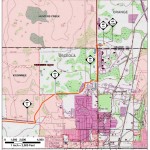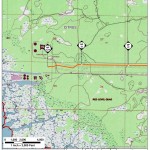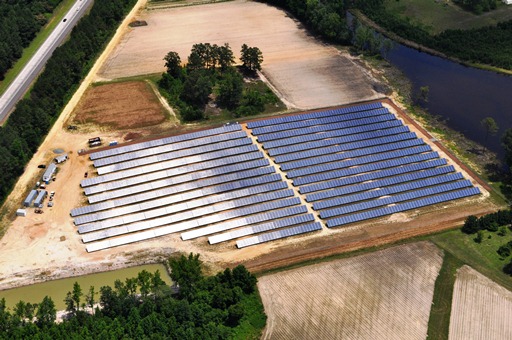 According to Sabal Trail’s own numbers, twice as much land for
the entire three-pipeline Spectra -> Sabal -> FSC proposed gouge
through three states
as would be required to produce as much solar power.
According to Sabal Trail’s own numbers, twice as much land for
the entire three-pipeline Spectra -> Sabal -> FSC proposed gouge
through three states
as would be required to produce as much solar power.
STT’s solar acreage estimates from their Draft Resource Report 10: Alternatives (RR10) of November 2013,
Some of the largest completed solar photovoltaic power plants, also called solar parks or fields, have area efficiency of about 4.5 to 13.5 acres per MW (Solar by the Watt, 2009). Therefore, we estimate that the land requirements for a solar project that could produce 26,882 MW of power would range between 1,991 and 5,974 acres of permanent disturbance.
 At the
FERC Scoping Meeting in Moultrie, Georgia 5 March 2014,
once again I
asked to see the RFP and proposals by which the environmental assessment
contractor, Merjent, was selected.
John Peconom of FERC once again refused to release
those documents, and said the contractor is funded by the pipeline companies.
At the
FERC Scoping Meeting in Moultrie, Georgia 5 March 2014,
once again I
asked to see the RFP and proposals by which the environmental assessment
contractor, Merjent, was selected.
John Peconom of FERC once again refused to release
those documents, and said the contractor is funded by the pipeline companies.
The contractor is funded by the applicant and works at our direction.
Then that contractor gave an acreage figure for the pipeline project. You can hear him in the LAKE video. According to FERC’s transcript (I added the images and links), he said:
Good evening.
As John and Kevin indicated, my name is Mitchell Shields and I’m going to be working for John in preparing this environmental impact statement.
You know, what we wanted to do right now is give you all an understanding of the scope of the projects that will be evaluated in the EIS. So what we will be evaluating is called the Southeast Market Pipelines project, or SMP. It actually consists of three separate but related projects that are going to be evaluated in one EIS document under NEPA.
The main project that we’re going to be talking about tonight that we’re looking for comments on or expecting comments is related to the Sabal Trail project, which is proposed by Sabal Trail Transmission LLC. The other two projects are known as — they’re called the Florida Southeast Connection project and the Hillabee Expansion project, also known as FSC or Hillabee Expansion.
This map shows how the projects are related to each other in the southeastern United States. Up in Alabama — oops, wrong button — is the Hillabee Expansion project, which consists of new pipeline and new compression facilities along an existing system — excuse me, new pipeline loop and new compression.
Down in the lower central part of Florida is the Florida Southeast Connection project. And in between is the Sabal Trail project, which consists of — well, let me back up here.
Florida Southeast Connection includes just new pipeline. Sabal Trail is new pipeline, new compression, and two laterals. One is called the Citrus County line and the other is the Hunter Creek line.
He didn’t say, but according to
Kevin Spear in the Orlando Sentinel 10 December 2013,
 Public meetings set for proposed natural gas line,
Public meetings set for proposed natural gas line,
Also to be connected to the end of the Sabal Trail pipe is a proposed pipeline called the Hunters Creek Line that would extend 14 miles to connect in Orange County with the state’s largest pipeline, which belongs to Florida Gas Transmission Co. LLC.
 The Citrus County Pipeline is the one to feed
Duke Energy’s Crystal River fracked methane power plant.
(Or will it?)
The Citrus County Pipeline is the one to feed
Duke Energy’s Crystal River fracked methane power plant.
(Or will it?)
But finally to Merjent’s acreage point:
When combined in total these projects would impact approximately 13,670 acres of land with temporary construction impacts that would
be associated with what’s typically between 100 and 110 feet of construction right-of-way in uplands and 75 feet in wetlands. And after they’re through they would require approximately 4,320 acres to maintain the pipeline and above-ground facilities for operation.
He neglected to mention that 100-foot RoW requires tearing down every tree. That would be permanent disturbance as far as the lifetimes of many of the people attending that Moultrie FERC Scoping Meeting. Even his low-end estimate of 4,320 acres is more than my previous estimate of 3,030 acres for the pipeline, presumably because Merjent’s Sheilds included the offshoot pipelines and he had better mileage counts.
So, 13,670 acres for the pipeline project is more than twice the 5,974 acres Sabal Trail’s RR10 said would be required for solar PV. Comparing low ranges, 4,320 is more than twice 1,991. And those numbers are all from STT or from STT’s preferred contractor.
 Why would we want a dangerous, dirty, property-taking fracked methane pipeline
when we can go directly to clean, safe, no-fuel solar power,
and have it installed faster and cheaper with local power and local jobs?
Why would we want a dangerous, dirty, property-taking fracked methane pipeline
when we can go directly to clean, safe, no-fuel solar power,
and have it installed faster and cheaper with local power and local jobs?
-jsq
Short Link:
Pingback: FERC has to consider cumulative pipeline effects | SpectraBusters
Pingback: Pipeline EIA insufficient without interstate highway option –EPA | SpectraBusters
Pingback: Brenham, Texas, and the highly dangerous character of gas and its tendency to escape | SpectraBusters